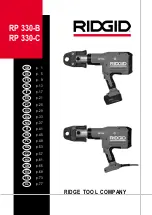
6
Operation
1. The Air Hammer must be properly lubricated
before operating. See “Maintenance” section
for oiling instructions.
2. Pull back on the knurled ring of the chuck
and insert the chisel shank into the chuck
(Figure 1). The ledge on the shank must go
beyond the four steel balls inside the chuck
in order to be secured. (NOTE: It may
require some force to move the chisel ledge
beyond the steel balls.) When the chisel is
installed, release the knurled ring.
3. Remove the protective cap from the air inlet,
and connect the air hammer to the air
supply. Make sure the air pressure is set to
90psi.
IMPORTANT:
Connecting a quick-change
coupling directly to the air hammer is not
recommended, as vibration may cause the
connection to fail. Instead, add a leader
hose and install any quick-change couplings
farther down the line.
4. Press the blade of the chisel against the
target surface, and press the trigger to begin
the hammering action. Adjust the speed as
needed with the regulator knob (Figure 2).
Maintenance
The Air Hammer should be lubricated daily (or
before each use) with air tool oil through the air
inlet. During continual operation, it should be
oiled every 1 to 2 hours. This can be done either
with an in-line oiler, or manually. If done
manually, proceed as follows:
1. Disconnect the air hose from the air
hammer.
2. Place one or two drops of air tool oil* into
the air inlet (Figure 2).
[*NOTE: Air tool oil not provided. It may be
purchased from your JET dealer, or is
available at most major hardware and tool
stores. SAE #10 weight oil may be used as
a substitute. Do not use detergent oil.]
3. Re-connect the air. Run the air hammer for
a few seconds to distribute the oil
throughout the tool. NOTE: Excess oil may
be propelled from the cylinder of the tool;
point it in a safe direction.
4. When finished operating the air hammer,
before storing it disconnect the air hose and
place 4 or 5 drops of air tool oil into the air
inlet; re-connect the air and run the tool for a
few seconds to distribute the oil.
5. Avoid storing the air hammer in very humid
locations which promotes rusting of internal
mechanisms, and always oil it before
storage.
Figure 1
Figure 2
Air Connection
1. Make sure the air compressor supplies
clean air at the correct CFM for the air
hammer.
Excess air pressure and/or
unclean air will shorten the tool’s life and
may create a hazardous situation.
2. Set air pressure to 90 psi.
3. Drain the water from the air compressor tank
daily, as well as any condensation from the
air lines. Water in the air line may enter the
tool and cause damage.
4. Change filters on the air system on a regular
basis.
5. Air line pressure should be increased
accordingly to compensate for extra long air
hoses (usually over 25 feet). Inside diameter
of the hose must be a minimum of 3/8”.


























